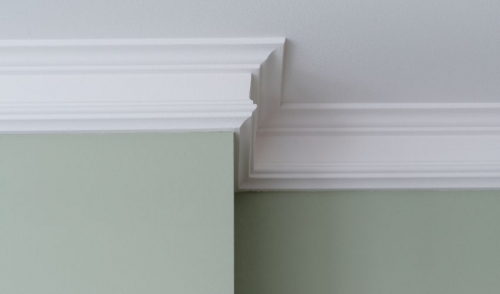
How Adding Molding Impacts a Space
Molding can be an astonishing finishing touch to any space, and the right molding can create a dramatic impact in any room. How can you make the most of your molding?
About Molding
Molding (or moulding) is a versatile accent and is available in different widths, depths, and profile shapes. Different types of molding can have carved details such as beading, arches, or rope-like patterns, and several pieces of molding can be layered to create deeper, more customized designs and larger profiles. Molding is typically made of wood, but can also be found in foam, plaster, plastic, and other materials to meet different needs and price points.
Depending on the style, molding can have many uses. It is often used along creases and joints to cover the space and create an attractive transition, such as between the ceiling and walls or the walls and the floor. Crown molding is used to accent height in a space, while baseboard is molding along the bottom of the wall and the floor. Molding can also be used as casing around windows, pass-throughs, or archways, or can create a chair rail or mimic a paneled wall. With the right use, molding can create an illusion of height or depth, ground a space, and otherwise transform an area.
Create the Best Impact With Molding
The best way to transform a room with molding will depend on many factors, including the room’s overall size, proportions, and design style. To ensure your molding has a positive, impressive impact in a space…- Coordinate the molding’s colors with the room’s overall palette. You may want a contrasting color for a greater pop to draw attention, or you may prefer a matching shade with a slightly different paint gloss for a more subtle effect.
- Proportionally size molding compared to the room’s overall size. A very large, elaborate molding can overwhelm a smaller space, while a thin, minimalist molding can look incomplete in a larger room.
- Coordinate the molding’s style with the room’s overall design. A very elaborate profile with carved details will look out of place in a room with modern, sleek décor, while a basic, simple molding will not adequately complete a room with a Victorian or vintage feel.
- Consider creating artwork with molding structures. Molding can be used to frame a gallery wall, highlight light fixtures, or create a display space, drawing the eye toward the decorative accents and pulling the look together.
- Use molding to separate textures, such as delineating changes in wall surfaces between painting and wallpaper, or separating paints with different finishes. This will help accent the changes and create a purposeful, elegant look.
- Always measure molding carefully to ensure a proper fit. Inaccurate measuring can create gaps or bulges that will give the overall project a shoddy, unseemly look, detracting from its total impact.
- Apply molding securely, using the proper adhesives (nails, glues, etc.) for the molding and surface materials and room conditions, such as humidity, heating, or potential moisture. This will ensure a smooth finish without warps or gaps that can make the molding less effective.
Investing in Molding
Molding is an easy way to update a space, giving the same room a unique and refreshed look on a minimal budget. This can be a great way to foster personal satisfaction and pride of ownership in your home, or to add a detailed touch that can increase your home’s value and appeal for sale. However you use molding, you can easily create a dramatic, professional impact that you will enjoy for years.
